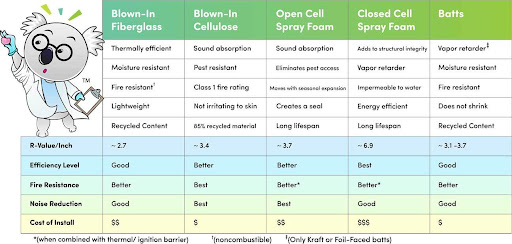
Types of insulation
Types of insulation
When it comes to insulation, there are a lot of choices to make. You need to consider the climate you live in, the type of home you have, and your budget. There are many different types of insulation available on the market, and each one has its own set of pros and cons. In this article, we will discuss the different types of insulation and help you choose the right one for your home!
Batt Insulation
Batt insulation is pre-cut and sized to fit most standard building sizes and are best suited for houses. This type of insulation can be used throughout the house, insulating floors, walls, and ceilings. Batt insulation is made from a variety of materials, including fiberglass, rock wool, and recycled denim.
Learn More About Batt Insulation
Pros
- Batt insulation is easy to install and can be done by most homeowners as a do-it-yourself project.
- This type of insulation is very effective at preventing heat transfer and keeping your home warm in the winter and cool in the summer.
- Batt insulation comes in a variety of R-values, so you can choose the level of insulation that best suits your needs.
Cons
- Batt insulation can be difficult to cut and fit around obstacles like pipes and wires.
- This type of insulation can be less effective if it is not properly installed or if there are gaps in the insulation.
Spray Foam Insulation
Created on-site by combining two chemicals, isocyanate and polyol resin, spray foam insulation is an expanding foam sprayed into the areas. This type of insulation is more versatile than batts as it can be used to not only insulate walls and attics, but due to its nature, can also be used to seal air leaks such as wiring holes, plumbing vents, open soffits, and attic hatches.
Learn More About Spray Foam Insulation
Pros
- Spray foam insulation is very effective at preventing heat transfer and keeping your home warm in the winter and cool in the summer.
- This type of insulation provides a tight seal that helps prevent air leaks.
- Spray foam insulation is fire resistant and does not absorb water.
Cons
- Spray foam insulation is more expensive than other types of insulation.
- This type of insulation can be difficult to install.
- If spray foam insulation is not properly installed, it can cause problems with moisture buildup.
Blow-In Insulation
Made up of either fiberglass, cellulose, or even mineral wool, blown-in insulation is — literally — blown into the space that one wishes to insulate. The small particles then join together to fill the space and create a solid barrier. Like spray foam, it can conform to the space with ease, reducing the need for additional sealing measures, such as is required when using batts.
Learn More About Blow-In Insulation
Pros
- Blow-in insulation is easy to install.
- This type of insulation can be used to insulate hard-to-reach areas.
- Blow-in insulation is fire resistant and does not absorb water.
Cons
- Blow-in insulation can be more expensive than other types of insulation.
- This type of insulation can be difficult to install in large spaces.
Learn How Insulation Can Save You Money On Your Energy Bills!
If you’re like most people, you’re always looking for ways to save money on your energy bills. Heating and cooling your home can be a major expense, but it doesn’t have to be. One of the best ways to reduce your energy costs is by installing insulation in your home. Insulation helps keep your home warm in the winter and cool in the summer, which can lead to significant savings on your energy bill.
Breakdown By R-Value
Batt Insulation
Batt insulation R-values, which measures the ability of the material to resist heat flow, range from 3.1 to 3.7 per inch; this means, for example, that a 3.5-inch thick batt will have an R-value of 15 and a. 8-inch thick batt will have one of 25. Depending on where you live, you will want a higher or lower R-value.
Spray Foam Insulation
The R-value per inch for spray foam varies, depending on whether or not one chooses open cell or closed cell, with closed offering the highest rating. For this type of insulation, it’s not just about the R-value, each type (open or closed) has its own properties that make it more — or less — effective. For example, those in a hot, dry climate are likely to use open-cell spray foam; but those who live in damper areas will want to pass since this type of insulation if more likely to trap moisture, risking mold, mildew, and structural damage. Closed-cell spray foam is more useful when it comes to vapor control.
Blow-In Insulation
The R-value for blown-in insulation ranges from 2.7 to 3.3 per inch, and depends on the material used as well as whether or not it is loose or dense packed. It should be noted that, while both blown-in and batts can be made with the same materials, the R-value depends on the density, meaning that blown-in fiberglass will have a lower R-value than fiberglass batts.
Ready to book your free insulation evaluation?
We have 3 convienant ways for you to get in touch
We Provide Insulation Services to the Following Michiana Areas
ELKHART, GRANGER, MISHAWAKA, NOTRE DAME, OSCEOLA, WAKARUSA, SOUTH BEND, BRISTOL, GOSHEN, MIDDLEBURY, MILFORD, MILLERSBURG, NAPPANEE, NEW PARIS, SHIPSHEWANA, SYRACUSE, TOPEKA, CROMWELL, LIGONIER, KINGSBURY, LA PORTE, MILL CREEK, ROLLING PRAIRIE, BREMEN, DONALDSON, HAMLET, LAKEVILLE, NEW CARLISLE, NORTH LIBERTY, PLYMOUTH, TYNER, WALKERTON
Counties Served
ELKHART, ST JOSEPH, KOSCIUSKO, LAGRANGE, NOBLE, LA PORTE, MARSHALL, STARKE
Zip Code
46514, 46530, 46544, 46545, 46556, 46561, 46573, 46615, 46617, 46635, 46637, 46507, 46516, 46517, 46526, 46528, 46540, 46542, 46543, 46550, 46553, 46565, 46567, 46571, 46732, 46767, 46345, 46350, 46365, 46371, 46506, 46513, 46532, 46536, 46552, 46554, 46563, 46572, 46574, 46601, 46613, 46614, 46616, 46619, 46628
